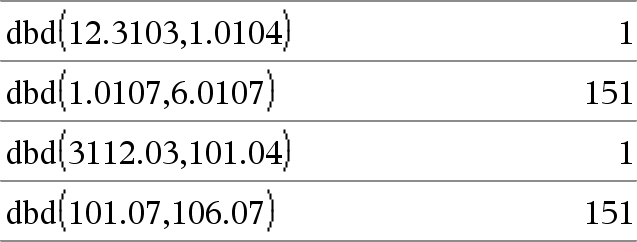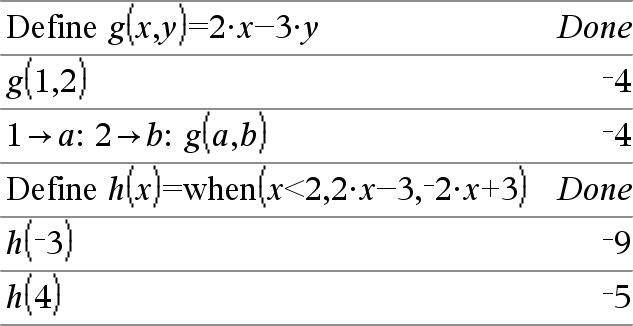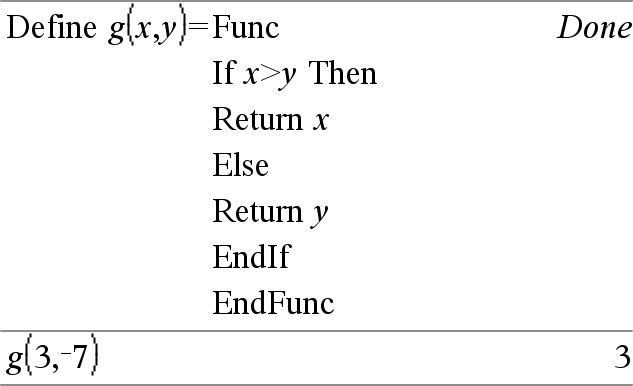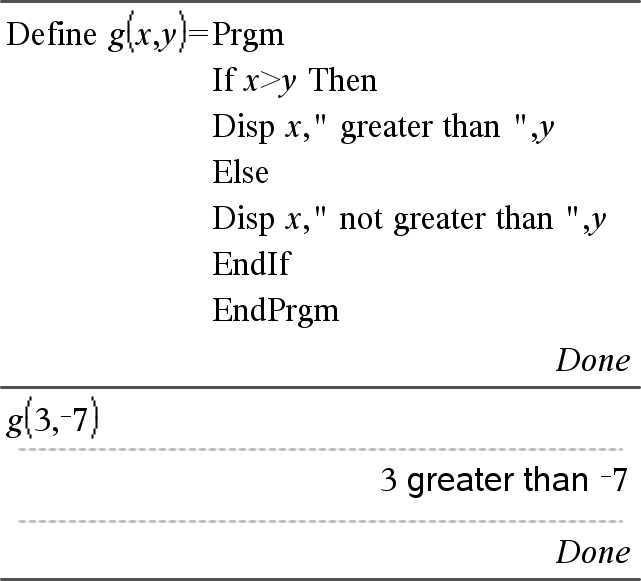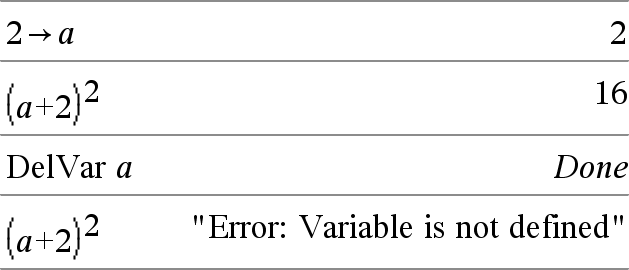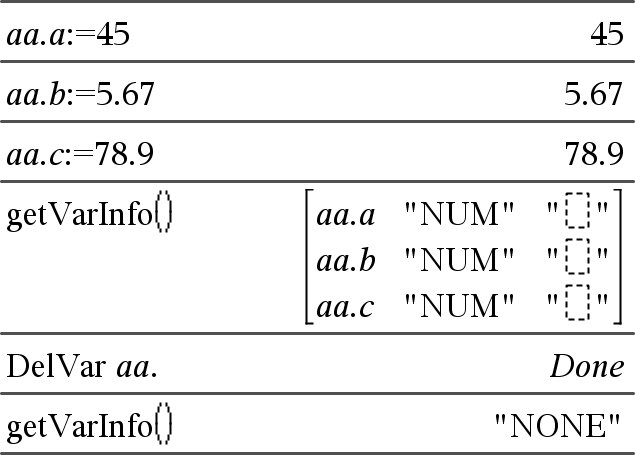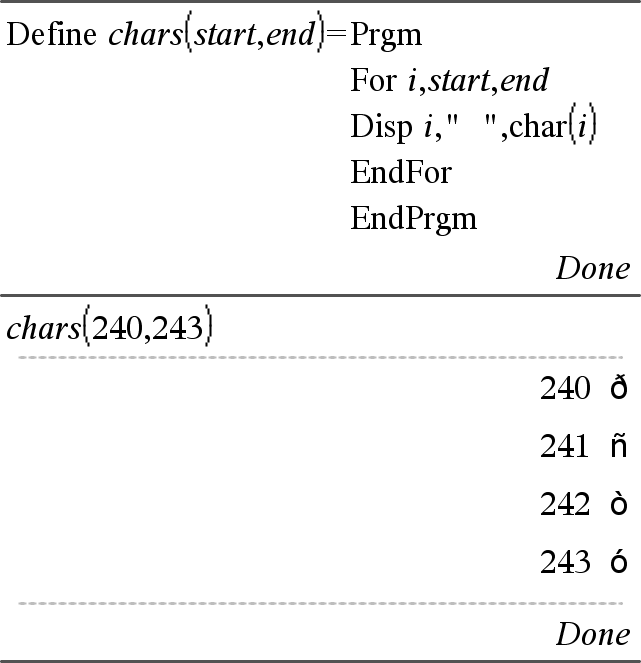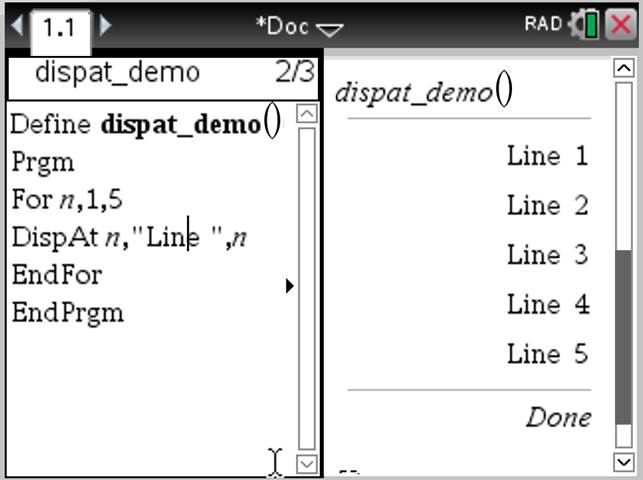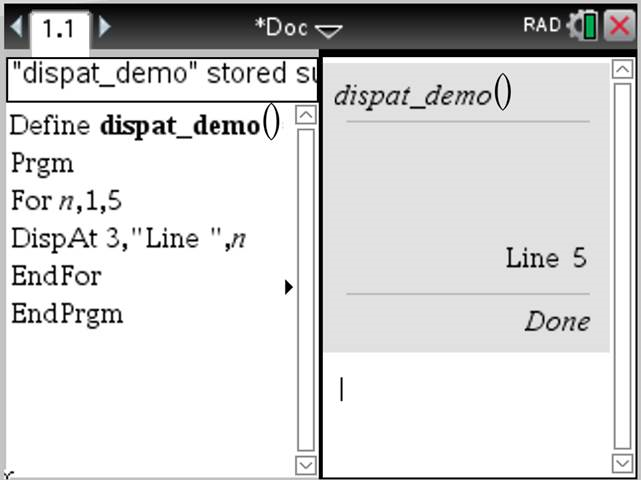|
Catalogue > |
|
|
dbd(date1,date2)Þvalue Returns the number of days between date1 and date2 using the actual-day-count method. date1 and date2 can be numbers or lists of numbers within the range of the dates on the standard calendar. If both date1 and date2 are lists, they must be the same length. date1 and date2 must be between the years 1950 through 2049. You can enter the dates in either of two formats. The decimal placement differentiates between the date formats. MM.DDYY (format used commonly in the United States) DDMM.YY (format use commonly in Europe) |
|
|
Catalogue > |
|
|
Expr1 4DDÞvalue List1 4DDÞlist Matrix1 4DDÞmatrix Note: You can insert this operator from the computer keyboard by typing @>DD. Returns the decimal equivalent of the argument expressed in degrees. The argument is a number, list, or matrix that is interpreted by the Angle mode setting in gradians, radians or degrees. |
In Degree angle mode:
In Gradian angle mode:
In Radian angle mode:
|
|
Catalogue > |
|
|
List1 4DecimalÞvalue Matrix1 4DecimalÞvalue Note: You can insert this operator from the computer keyboard by typing @>Decimal. Displays the argument in decimal form. This operator can be used only at the end of the entry line. |
|
|
Catalogue > |
|
|
Define Var = Expression Define Function(Param1, Param2, ...) = Expression Defines the variable Var or the user-defined function Function. Parameters, such as Param1, provide place holders for passing arguments to the function. When calling a user-defined function, you must supply arguments (for example, values or variables) that correspond to the parameters. When called, the function evaluates Expression using the supplied arguments. Var and Function cannot be the name of a system variable or built-in function or command. Note: This form of Define is equivalent to executing the expression: expression & Function(Param1,Param2). |
|
|
Define Function(Param1, Param2, ...) = Func Define Program(Param1, Param2, ...) = Prgm In this form, the user-defined function or programme can execute a block of multiple statements. Block can be either a single statement or a series of statements on separate lines. Block also can include expressions and instructions (such as If, Then, Else and For). Note for entering the example: For instructions on entering multi-line programme and function definitions, refer to the Calculator section of your product guidebook. Note: See also Define LibPriv, here, and Define LibPub, here. |
|
|
Catalogue > |
|
|
Define LibPriv Var = Expression Define LibPriv Function(Param1, Param2, ...) = Expression Define LibPriv Function(Param1, Param2, ...) = Func Define LibPriv Program(Param1, Param2, ...) = Prgm Operates the same as Define, except defines a private library variable, function, or programme. Private functions and programs do not appear in the Catalogue. |
|
|
Catalogue > |
|
|
Define LibPub Var = Expression Define LibPub Function(Param1, Param2, ...) = Expression Define LibPub Function(Param1, Param2, ...) = Func Define LibPub Program(Param1, Param2, ...) = Prgm Operates the same as Define, except defines a public library variable, function, or programme. Public functions and programs appear in the Catalogue after the library has been saved and refreshed. |
|
|
See @List(), here. |
|
|
|
|
|
|
|
|
Catalogue > |
|
|
DelVar Var1[, Var2] [, Var3] ... DelVar Var. Deletes the specified variable or variable group from memory. If one or more of the variables are locked, this command displays an error message and deletes only the unlocked variables. See |
|
|
DelVar Var. deletes all members of the Var. variable group (such as the statistics stat.nn results or variables created using the LibShortcut() function). The dot (.) in this form of the DelVar command limits it to deleting a variable group; the simple variable Var is not affected. |
|
|
Catalogue > |
|
|
Returns a list that has the contents of List1 with all empty (void) elements removed. For more information on empty elements, see here. |
|
|
Catalogue > |
|||||||
|
det(squareMatrix[, Tolerance])Þexpression Returns the determinant of squareMatrix. Optionally, any matrix element is treated as zero if its absolute value is less than Tolerance. This tolerance is used only if the matrix has floating-point entries and does not contain any symbolic variables that have not been assigned a value. Otherwise, Tolerance is ignored.
|
|
|
Catalogue > |
|
|
diag(List)Þmatrix diag(rowMatrix)Þmatrix diag(columnMatrix)Þmatrix Returns a matrix with the values in the argument list or matrix in its main diagonal. |
|
|
diag(squareMatrix)ÞrowMatrix Returns a row matrix containing the elements from the main diagonal of squareMatrix. squareMatrix must be square. |
|
|
Catalogue > |
|
|
dim(List)Þinteger Returns the dimension of List. |
|
|
dim(Matrix)Þlist Returns the dimensions of matrix as a two-element list {rows, columns}. |
|
|
dim(String)Þinteger Returns the number of characters contained in character string String. |
|
|
Catalogue > |
|
|
Disp exprOrString1 [, exprOrString2] ... Displays the arguments in the Calculator history. The arguments are displayed in succession, with thin spaces as separators. Useful mainly in programs and functions to ensure the display of intermediate calculations. Note for entering the example: For instructions on entering multi-line programme and function definitions, refer to the Calculator section of your product guidebook. |
|
|
Catalogue > |
|||||
|
DispAt int,expr1 [,expr2 ...] ... DispAt allows you to specify the line where the specified expression or string will be displayed on the screen. The line number can be specified as an expression. Please note that the line number is not for the entire screen but for the area immediately following the command/programme. This command allows dashboard-like output from programmes where the value of an expression or from a sensor reading is updated on the same line. DispAtand Disp can be used within the same programme. Note: The maximum number is set to 8 since that matches a screen-full of lines on the handheld screen - as long as the lines don't have 2D maths expressions. The exact number of lines depends on the content of the displayed information.
|
Example
Illustrative examples:
|
Error conditions:
|
Error Message |
Description |
|---|---|
|
DispAt line number must be between 1 and 8 |
Expression evaluates the line number outside the range 1-8 (inclusive) |
|
Too few arguments |
The function or command is missing one or more arguments. |
|
No arguments |
Same as current 'syntax error' dialogue |
|
Too many arguments |
Limit argument. Same error as Disp. |
|
Invalid data type |
First argument must be a number. |
|
Void: DispAt void |
"Hello World" Datatype error is thrown for the void (if the callback is defined) |
|
Catalogue > |
|
|
List 4DMS Matrix 4DMS Note: You can insert this operator from the computer keyboard by typing @>DMS. Interprets the argument as an angle and displays the equivalent DMS (DDDDDD¡MM'SS.ss'') number. See ¡, ', '' (here) for DMS (degree, minutes, seconds) format. Note: 4DMS will convert from radians to degrees when used in radian mode. If the input is followed by a degree symbol ¡ , no conversion will occur. You can use 4DMS only at the end of an entry line. |
In Degree angle mode:
|
|
Catalogue > |
|
|
dotP(List1, List2)Þexpression Returns the “dot” product of two lists. |
|
|
dotP(Vector1, Vector2)Þexpression Returns the “dot” product of two vectors. Both must be row vectors, or both must be column vectors. |
|

